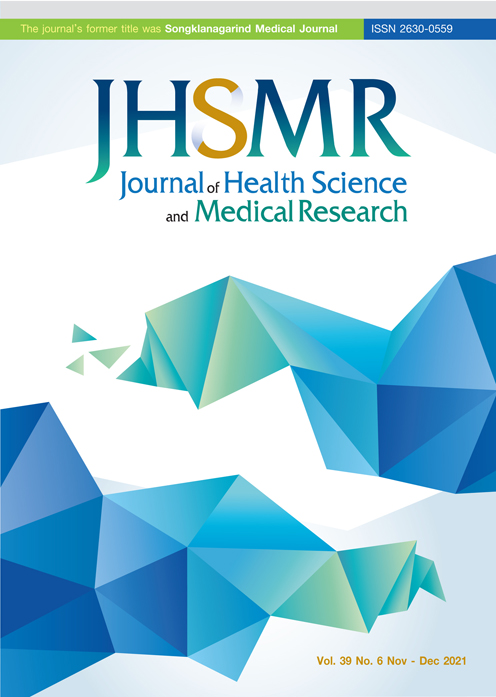Prevalence of Imipenemase and Verona Integron-Encoded Metallo- β-Lactamase in Imipenem-Resistant Pseudomonas aeruginosa
DOI:
https://doi.org/10.31584/jhsmr.2021805Keywords:
blaIMP, blaVIM, imipenem-resistant, metallo-β-lactamase, Pseudomonas aeruginosaAbstract
Objective: To determine the prevalence of metallo-β-lactamase (MBL) including imipenemase (IMP) and Verona integronencoded metallo-β-lactamase (VIM) in imipenem-resistant Pseudomonas aeruginosa (IRPA) isolates and investigate the in vitro activities of 9 antimicrobial agents against MBL-positive isolates.
Material and Methods: Seventy-eight IRPA isolates were obtained from Songklanagarind Hospital. MBL production was detected by the combined-disk test, and the blaIMP and blaVIM genes were determined via Polymerase Chain Reaction (PCR). The in vitro activities of amikacin, gentamicin, aztreonam, ceftazidime, meropenem, ciprofloxacin, colistin, piperacillin/ tazobactam, and ticarcillin/clavulanate were determined using the E-test method.
Results: Of the 78 IRPA isolates, 20 (25.6%, 95% CI 17.2-36.4%) were MBL phenotype-positive, and 30 (38.5%, 95% CI 28.5-49.6%) were MBL genotype-positive (29 Imipenemase (IMP)-type and 1 Verona integron-encoded metallo-β- lactamase (VIM)-type). Ninety percent of the MBL genotype-positive isolates were MDR. Most MBL genotype- positive isolates were susceptible to colistin (susceptibility rate of 96.7% and MIC50 value of 1.5 μg/mL).
Conclusion: Our results showed a high prevalence of MBL-positive isolates (38.5%) in IRPAs, and the IMP-type isolates were dominant among the metallo-β-lactamase-producing imipenem-resistant P. aeruginosa tested. Most MBL-positive isolates were susceptible to colistin and had low MIC50 values.
References
Hong DJ, Bae IK, Jang IH, Jeong SH, Kang HK, Lee K. Epidemiology and characteristics of metallo-β-lactamaseproducing Pseudomonas aeruginosa. Infect Chemother 2015;47: 81-97.
Hirakata Y, Yamaguchi T, Nakano M, Izumikawa K, Mine M, Aoki S, et al. Clinical and bacteriological characteristics of IMP-type metallo-β-lactamase-producing Pseudomonas aeruginosa. Clin Infect Dis 2003;37:26-32.
Carmeli Y, Akova M, Cornaglia G, Daikos GL, Garau J, Harbarth S, et al. Controlling the spread of carbapenemase-producing gram-negatives: therapeutic approach and infection control. Clin Microbiol Infect 2010;16:102-11.
Khuntayaporn P, Montakantikul P, Santanirand P, Kiratisin P, Chomnawang MT. Molecular investigation of carbapenem resistance among multidrug-resistant Pseudomonas aeruginosa isolated clinically in Thailand. Microbiol Immunol 2013;57:170-8.
Cornaglia G, Giamarellou H, Rossolini GM. Metallo-β-lactamase: a last frontier for β-lactams? Lancet Infect Dis 2011;11:381-93.
Biradar S, Roopa C. Prevalence of metallo-beta-lactamase producing Pseudomonas aeruginosa and its antibiogram in a tertiary care centre. Int J Curr Microbiol App Sci 2015;4:952-6.
Acharya M, Joshi PR, Thapa K, Aryal R, Kakshapati T, Sharma S. Detection of metallo-β-lactamases-encoding genes among clinical isolates of Pseudomonas aeruginosa in a tertiary care hospital, Kathmandu, Nepal. BMC Res Notes 2017;10:718.
Piyakul C, Tiyawisutsri R, Boonbumrung K. Emergence of metallo-β-lactamase IMP-14 and VIM-2 in Pseudomonas aeruginosa clinical isolates from a tertiary-level hospital in Thailand. Epidemiol Infect 2012;140:539-41.
Giligan PH. Pseudomonas and Burlkholder. In: Murray PR, Baron EJ, Pfaller MA, Tenover FC, Yolken RH, editors. Manual of clinical microbiology. 6th ed. Washington, DC: ASM Press; 1995;p.509-19.
Aghamiri S, Amirmozafari N, Mehrabadi JF, Fouladtan B, Kafil HS. Antibiotic resistance pattern and evaluation of metallo-beta lactamase genes including bla-IMP and bla-VIM types in Pseudomonas aeruginosa isolated from patients in Tehran hospitals. ISRN Microbiol [serial on the Internet]. 2014 [cited 2019 Jun 6]. Available from: http://dx.doi.org/10.1155/2014/ 941507
Adjei CB, Govinden U, Moodley K, Essack SY. Molecular characterisation of multidrug-resistant Pseudomonas aeruginosa from a private hospital in Durban, South Africa. South Afr J Infect Dis 2018;33:38-41.
Franklin C, Liolios L, Peleg AY. Phenotypic detection of carbapenem- susceptible metallo-β-lactamase-producing gramnegative bacilli in the clinical laboratory. J Clin Microbiol 2006; 44:3139-44.
Jean B, Melvin P, George M, Stephen G, James S, Brandi L, et al. Performance standards for antimicrobial susceptibility testing. 27th ed. Pennsylvania: Clinical and Laboratory Standards Institute; 2017;p.42-5.
Huang YT, Chang SC, Lauderdale TL, Yang AJ, Wang JT. Molecular epidemiology of carbapenem-resistant Pseudomonas aeruginosa carrying metallo-β-lactamase genes in Taiwan. Diagn Microbiol Infect Dis 2007;59:211-6.
Laupland KB, Parkins MD, Church DL, Gregson DB, Louie TJ, Conly JM, et al. Population-based epidemiological study of infections caused by carbapenem-resistant Pseudomonas aeruginosa in the Calgary health region: importance of metallo- β-lactamase (MBL)-producing strains. J Infect Dis 2005; 192:1606-12.
Ranjan S, Banashankari GS, Sreenivasa Babu PR. Comparison of epidemiological and antibiotic susceptibility pattern of metallobeta- lactamase-positive and metallo-beta-lactamase-negative strains of Pseudomonas aeruginosa. J Lab Physicians 2014; 6:109-13.
Khorvash F, Yazdani M, Shabani S, Soudi A. Pseudomonas aeruginosa producing metallo-β-lactamases (VIM, IMP, SME, and AIM) in the clinical isolates of intensive care units, a university hospital in Isfahan, Iran. Adv Biomed Res 2017;6: 147.
Abaza AF, El Shazly SA, Selim HSA, Aly GSA. Metallo-betalactamase producing Pseudomonas aeruginosa in a healthcare setting in Alexandria, Egypt. Pol J Microbiol 2017;66:297- 308.
Leung CH, Wang NY, Liu CP, Weng LC, Hsieh FC, Lee CM. Antimicrobial therapy and control of multidrug-resistant Pseudomonas aeruginosa bacteremia in a teaching hospital in Taiwan. J Microbiol Immunol Infect 2008;41:491-8.
Dalfino L, Puntillo F, Ondok MJ, Mosca A, Monno R, Coppolecchia S, et al. Colistin-associated acute kidney injury in severely III patients: a step toward a better renal care? a prospective cohort study. Clin Infect Dis 2015;61:1771-7.
Memar MY, Pormehrali R, Alizadeh N, Ghotaslou R, Baghi HB. Colistin, an option for treatment of multiple drug resistant Pseudomonas aeruginosa. Physiol Pharmacol 2016;20:130-6.
Barros EMLR, Morais VMS, Castro KCB, Orsi AR, Maranhao FCA, Silva ZP, et al. First detection of metallo- β-lactamases in nosocomial isolates of Pseudomonas aeruginosa in Alagoas, Brazil. J Bras Patol Med Lab 2015;51: 291-5.
Rostami S, Sheikh AF, Shoja S, Farahani A, Tabatabaiefar MA, Jolodar A, et al. Investigating of four main carbapenem-resistance mechanisms in high-level carbapenem resistant Pseudomonas aeruginosa isolated from burn patients. J Chin Med Assoc 2018; 81:127-32.
Downloads
Published
How to Cite
Issue
Section
License

This work is licensed under a Creative Commons Attribution-NonCommercial-NoDerivatives 4.0 International License.
























